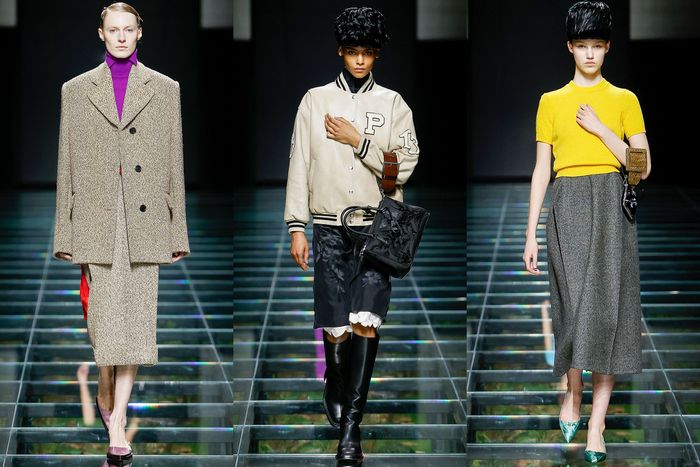Hats, aprons, slips, bows, tablecloths, gloves, bras, stoles, trains, bustles, flowers, bloomers: If you gather up the most mundane female trappings over time, and throw in the harder edge of masculine tailoring, you get Prada. And if you dissect Prada, you get fashion. You can point to any number of other designers who’ve used that mix to create new fashion — Jean Paul Gaultier, Martin Margiela, and Rei Kawakubo of Comme des Garcons, to mention just three. But this season, the collection of Miuccia Prada and Raf Simons felt doubly strange, partly because it seemed to link up with the nostalgia that is everywhere and partly because some of the clothing is a challenge to wear.
Perspective really counted in this show in terms of what you understood about the clothes. First, the floor of the Prada show space was specially made of clear glass mounted on a metal frame about three feet above a kind of terrarium, with ferns, grasses, and a stream running through the center. So there was the sensation of floating — for the audience and the models — and the creepy aspect of the terrain, which, of course, you couldn’t touch or smell.
Second, and most importantly, if you see the clothes face-on — as most of the photographers did — you’d have the impression of an immaculate suit in dark expensive wool, somewhat lean in form, with the skirt just below the knees. But if you were sitting along the sides of the runway, you saw a different outfit. The strict jacket seemed to gain more elegant volume and the skirt, well, it was only half a skirt. Only the front portion existed and the model’s pastel or white silk slip was exposed in the rear. Oops!
This is hardly a new device in fashion. Twenty-five years ago, it was a thing to wear a blazer or sweater with a half-slip — with heels and no stockings. The stylist Camilla Nickerson was the first person I saw do it. Prada herself has used lingerie in her collections. And designers have shown variations on proper tailored clothes that have been cut away or, if you like, deconstructed. I remember buying a pinstriped wool maxi dress by Margiela at Barneys. Based on a men’s waistcoat, the back was silk and stopped just below my butt. Simons and Prada also did a coat or two with a silk back.
But to isolate or focus on any one gesture or fragment in this engaging collection is to miss the designers’ point and, ultimately, the compact picture of women’s and fashion history that it offered. “I look at history very much to learn something,” Prada said backstage, emphasizing women’s history and adding, “Nostalgia is not the point at all.” Simons said they began work on the collection by discussing love and romance, and the ideas leapfrogged from there. “It’s just instinctive,” he said of some of their designs. “And not everything is explainable.”
In a sense, the designers were throwing light on things that have, in part, made up many women’s lives. The slips, for example, were appliquéd with flowers and actually referenced beautiful table linen. A model wore a pink pullover with a purple slip and a straight-cut fragment of a brown tweed skirt with a cuff at the hem. A purple cord was tied around her waist. Was the skirt, in essence, an apron? Or a trouser leg? Either way, it’s an interesting abstraction of women’s history, at least among the middle and upper classes — from being stuck at home to wearing pants and being free. The “skirt” suit worn by Julia Nobis raises the same question, but her jacket is equally curious. Viewed face-on, it appears two-dimensional, like a paper doll’s garment. Indeed, many of the clothes have that effect — until you see the model in full.
Prada and Simons built that human complexity into their collection, and they did it in modest and tender ways, too. Under some dresses were bloomers. They’re a nice change from shorts, and funnier. Satin bows embellished many shifts, though somehow a Prada bow doesn’t look dumb. It retains the strangeness that is Prada. The designers also evoked the glamour of the 1950s, with a series of opera coats and off-the-shoulder cocktail dresses in what looked like black or purple silk taffeta. But when you find out the fabric is technical nylon, the styles escaped their historical cage. The final black coast dress, with a fitted bodice and a high neck, was just superb.
Some of the clothes will be challenging to wear — or, like those apron/dangling trouser-leg skirts, just plain annoying. But despite the fact that I sometimes felt there was more brain than feeling in the collection, it was a pleasure to see Prada and Simons push their conversation further. As Simons has said, fashion doesn’t always have to be accessible or even immediately acceptable.
In 65 looks, on a remarkably long runway, Peter Hawkings covered the Tom Ford waterfront on Thursday night. He had clingy catsuits in black net, gowns in liquid jersey and body-molded forms, sexy three-piece suits in slick fabrics, and a nice spree of military styles in dark wool for men and women. The fit was impeccable and generally snug, the quality plainly high. And the show was an improvement over Hawkings’s debut last fall. The problem, however, was that this very structured form, if not the sensibility behind it, doesn’t feel modern. There are undoubtedly many women who want to look super polished, but they also might appreciate less rigid formula and more looseness of mind from Hawkings.





